1.导入easygui模块
(1)保持easygui命名空间,减少字符输入量(推荐)
import easygui as e e.msgbox('hello')
(2)最简单,但是在函数前需要加easygui
import easygui easygui.msgbox('hello')
(3)导入整个easygui包,调入函数的时候可以直接写代码
from easygui import * msgbox('hello')
三种方式弹出的消息框是一样的
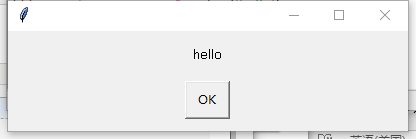
2.使用easygui
import easygui as e #输入命名空间 import sys
while 1: #输入循环,该条件下为true,将无限循环下去 e.msgbox('今天天气怎么样?') #调出消息框 msg='日记' #选择框属性赋值 title='你的心情好吗?' choices=['好','不好','还行'] choice=e.choicebox (msg,title,choices) #返回选择框结果 e.msgbox ('你的选择是'+str(choice)) #调出消息框 msg='还有什么要说的吗?' #继续取消框属性赋值 title='请选择' if e.ccbox(msg,title): #继续则循环 pass else: sys.exit(0) #取消则退出
保存为.py文件,再运行
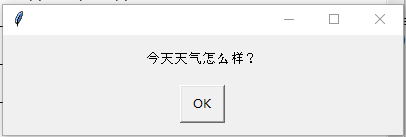


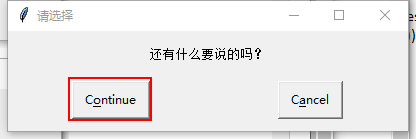
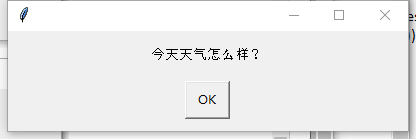
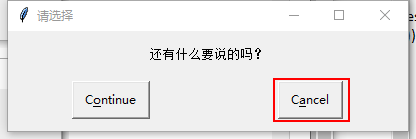
退出程序
3.拓展
msgbox()
msgbox(msg="(Your message goes here)", title="", ok_button="OK",image=None,root=None)
ccbox()
ccbox(msg='shall I contineue?',title='',choices=('Continue'.'Cancel',image=None)
ccbox()返回1(continue)或者0(cancel)
buttonbox()
buttonbox(msg='',title='',choices=('Button1','Button2','Button3'),image=None,root=None)
返回按钮的文本内容。如果用户取消或关闭窗口,返回默认选项(第一个选项)
indexbox()
indexbox(msg='Shall I continue?',title='',choices=('Yes','NO'),image=None)
选第一个按钮返回序号0,选第二个返回序号1
boolbox()
boolbox(msg='Shall I continue?',title='',choices=('Yes','No'),image=None)
选第一个按钮返回1,否则返回0
choicebox()
choicebox()(msg='',title='',choices=())
为用户提供一个可选择列表,使用序列(元祖或列表)作为选项,选择一个选项
multchoicebox()
multchoicebox(msg='',title='',choices=(),**kwargs)
提供可选择列表,可以同时选择0个、1个或者多个
enterbox()
enterbox(msg='enter something',title='',default='',strip=true,image=None,root=None)
简单输入框,返回输入字符串
integerbox()
imtegerbox(msg='',title='',lowerbound=0,upperbound=99,imgage=None,root=None,**invalidKeywordArgmts)
简单输入框,只能输入范围内的整数值(lowerbound,upperbound),否则要求重新输入
(更多学习文档,参见http://bbs.fishc.com/thread-46069-1-1.html)